Planning balanced meals is a cornerstone of a healthy lifestyle which is beneficial to the maximum.
- 1. What is Balanced Meal Planning?
- 2. Understanding Essential Macronutrients and Their Role
- 3. Proven Benefits of Balanced Meal Planning
- 4. Creating a Weekly Meal Plan
- 5. Incorporating Essential Seasonal and Local Ingredients
- 6. Mind-blowing Tips for Meal Prep and Batch Cooking
- 7. Balancing Flavors and Textures
- 8. Planning for Dietary Restrictions and Preferences
- 9. Healthy Snacks and Hydration
- 10. Tracking Progress and Adjusting Plans
1. What is Balanced Meal Planning?
Balanced meal planning involves creating meals that effectively meet your body’s needs for macronutrients, such as carbohydrates, proteins, and fats, as well as essential micronutrients like- vitamins and minerals. Moreover, it’s about incorporating a variety of foods and ensuring you consume enough nutrients to support your overall health and wellness. By including diverse ingredients and focusing on balance you can create meals that nourish your body and promote long-term well-being.
Key Points for Balanced meal planning
- Macronutrients: Provide energy, repair, and overall functionality.
- Micronutrients: Support immunity, cell repair, and metabolic functions.
- Proportions: Use the “Healthy Plate Method” to divide meals into vegetables, proteins, and carbs.
Benefits:
- Prevent nutrient deficiencies.
- Manage energy levels effectively.
- Promote long-term health.
Visual: Infographic of the “Healthy Plate Method,” showing proportions of food groups.

Fig. 2.1 is an infographic of the “Healthy Plate Method,” showing the proportions of food groups.
2. Understanding Essential Macronutrients and Their Role
Each macronutrient plays a critical role in maintaining your health. Balancing these ensures your body functions optimally:
- Carbohydrates: Primary energy source. Found in whole grains, fruits, and vegetables.
- Proteins: Build and repair tissues. Best sources include lean meats, beans, and tofu.
- Fats: Essentials for brain health and hormone production. Introduce healthy fats such as nuts, avocados, and olive oil into your choice.
Tips:
- Limit processed carbs and unhealthy fats.
- Combine macronutrients in every meal for sustained energy.
Visual: Chart listing common foods rich in each macronutrient category.
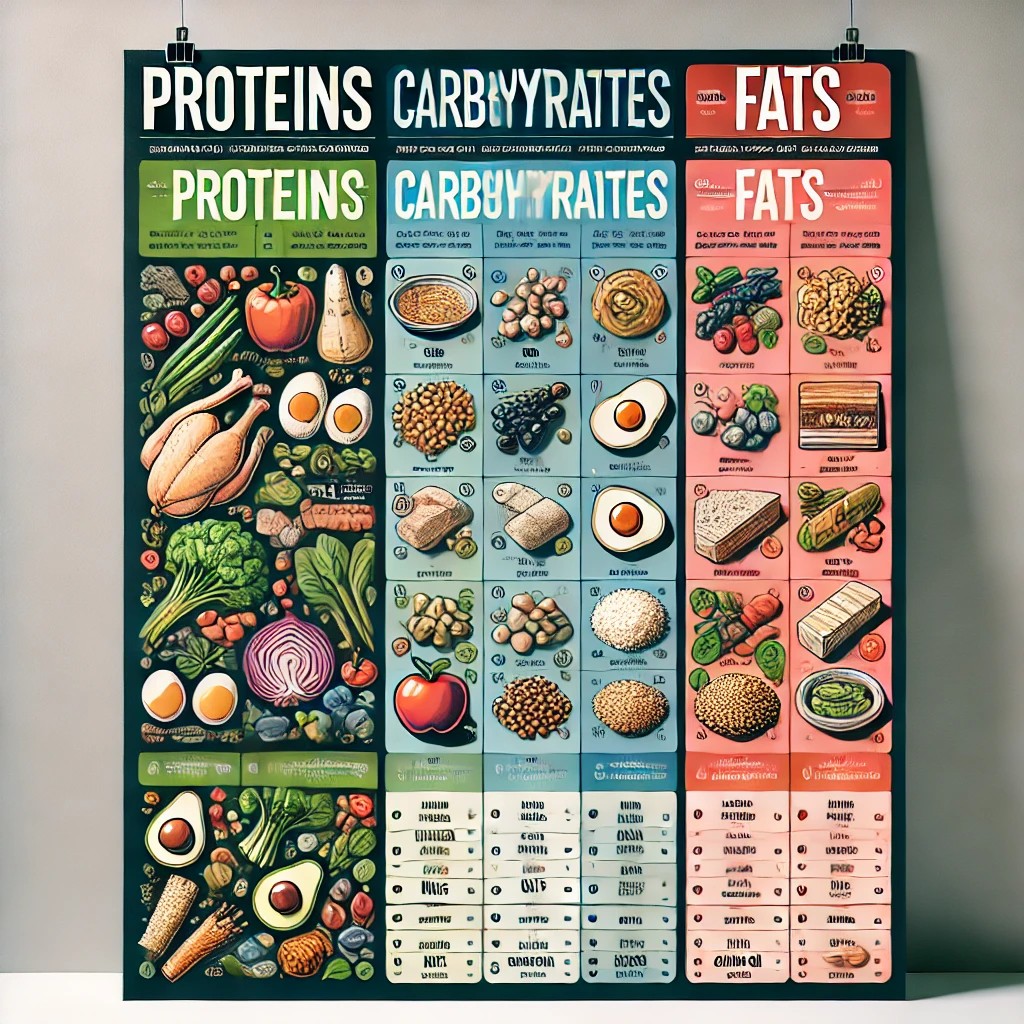
Here fig. 2.2 is the chart listing common foods rich in each macronutrient category.
3. Proven Benefits of Balanced Meal Planning
Balanced meal planning offers numerous benefits that extend beyond physical health:
- Nutritional Balance: Provides essential vitamins and minerals.
- Cost Efficiency: Saves money by reducing impulse purchases.
- Time Management: Simplifies cooking and grocery shopping.
- Improved Energy: Reduces fatigue and improves focus.
Visual: Comparison table of “planned meals” vs. “unplanned eating” benefits.
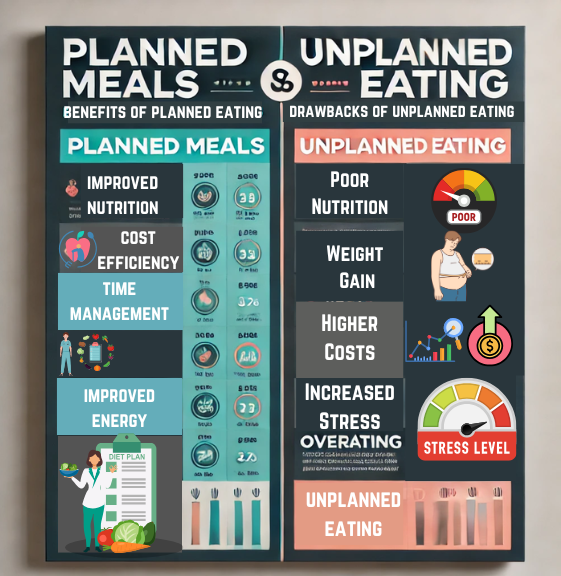
Here fig, 2.3 is the comparison table of “Planned Meals” versus “Unplanned Eating” benefits.
4. Creating a Weekly Meal Plan
A structured weekly plan ensures variety and convenience. Creating a weekly meal plan is a powerful strategy for managing your time, health, and budget effectively. It involves organizing meals for the week ahead and ensuring a balanced diet that caters to your nutritional needs and lifestyle preferences. By planning your meals, you can reduce the stress of last-minute decisions, minimize food waste, and save money by avoiding unnecessary takeout or grocery store splurges. Whether you aim to eat healthier, accommodate dietary restrictions, or simplify your routine, a well-thought-out meal plan can be a game-changer for your overall well-being. Steps include:
- Set Goals: Determine dietary objectives (e.g., weight loss, muscle gain).
- Inventory Check: Assess pantry items to minimize waste.
- Plan Meals: Include proteins, veggies, and carbs in every meal.
- Prep Ahead: Batch-cook staples like quinoa, chicken, or roasted vegetables.
Tips:
- Rotate meals to prevent monotony.
- Plan for quick, nutrient-dense breakfasts and snacks.
Visual: Printable meal planning calendar template with sections for breakfast, lunch, dinner, and snacks.

Fig. 2.4 above shows a printable meal planning calendar template with sections for breakfast, lunch, dinner, and snacks.
5. Incorporating Essential Seasonal and Local Ingredients
Incorporating essential seasonal and local ingredients into your meals is an excellent way to elevate your cooking while supporting sustainability. Seasonal produce is often fresher, more flavorful, and packed with nutrients, as it is harvested at its peak ripeness. Sourcing locally reduces the environmental impact of long-distance transportation and promotes your community’s farmers and businesses. Additionally, cooking with seasonal ingredients can inspire creativity in the kitchen, as you adapt to the changing flavors of each season. This approach, not only enhances your meals but, also fosters a deeper connection to nature and the food you consume. In short, seasonal and locally sourced foods enhance flavor, reduce costs, and support sustainability:
Conclusively
- Seasonal Produce: Provides peak nutrition and freshness.
- Local Sourcing: Reduces environmental impact and supports local farmers.
- Variety: Introduces unique flavors and prevents dietary monotony.
Tips:
- Visit farmers’ markets to explore fresh options.
- Use a seasonal produce chart to guide purchases.
Visual: Colorful seasonal food calendar highlighting fruits and vegetables by month.

Fig. 2. 5 above shows a colorful seasonal food calendar highlighting fruits and vegetables by month.
6. Mind-blowing Tips for Meal Prep and Batch Cooking
Meal prep and batch cooking are efficient strategies for saving time, reducing stress, and ensuring consistent healthy eating throughout the week. Begin with a plan for your meals, and create a detailed shopping list to avoid unnecessary purchases. Arrange quality storage containers to keep your meals organized, fresh, and healthy. Focus on preparing versatile ingredients, such as roasted vegetables or cooked grains, that can be used across multiple dishes. Cook in bulk to maximize your efforts and freeze portions for later. By dedicating a few hours to meal prep you can streamline your daily routine and enjoy nutritious, homemade, and delicious meals. Meal prepping saves time and ensures balanced eating even during busy weeks:
- Batch Cook Staples: Prepare versatile items like rice, beans, or roasted chicken.
- Portion Meals: Store in individual containers for easy grab-and-go.
- Label Containers: Include meal contents and expiration dates.
Batch Cook Staples: Prepare versatile items like rice, beans, or roasted chicken.
Portion Meals: Store in individual containers for easy grab-and-go.
Label Containers: Include meal contents and expiration dates.
Pro Tips:
- Invest in quality storage containers to preserve freshness.
- Include freezer-friendly meals like soups or casseroles.
Visual: Image of a refrigerator neatly organized with labeled meal prep containers.
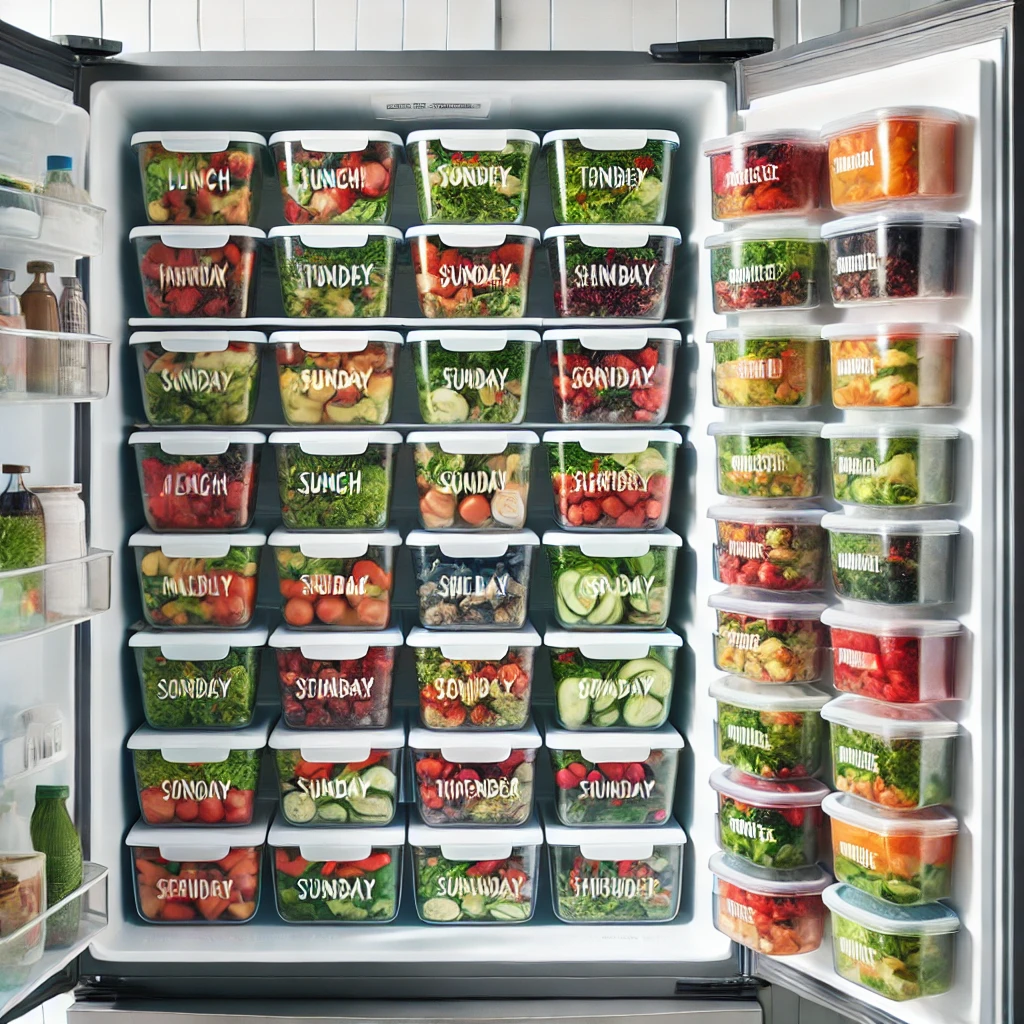
Fig. 2.6 shows an image of a refrigerator neatly organized with labeled meal prep containers.
7. Balancing Flavors and Textures
Balancing flavors and textures is key to creating meals that are, both satisfying and memorable. A well-balanced dish combines the five basic tastes—sweet, salty, sour, bitter, and umami to have complete harmony. For example, adding a pinch of sweetness can counteract sour or bitter notes, while a sprinkle of salt can enhance natural flavors. Equally important is texture; incorporating several elements like crunchy, creamy, tender, and crisp adds depth and keeps your palate engaged. Experimenting with complementary flavors and diverse textures transforms ordinary meals into culinary delights that excite your taste buds. A balanced meal is not just nutritionally adequate but also satisfying to the palate:
Flavors: A mixture of salty, sweet, bitter, sour, and umami elements.
Textures: Incorporate crunchy, creamy, and tender components.
Visual Appeal: Use colorful ingredients to make meals appetizing.
Tips:
- Experiment with Spices and herbs to increase natural flavors.
- Pair crisp vegetables with creamy dressings or dips.
Visual: Vibrant plate of diverse foods showcasing variety in colors, textures, and flavors.
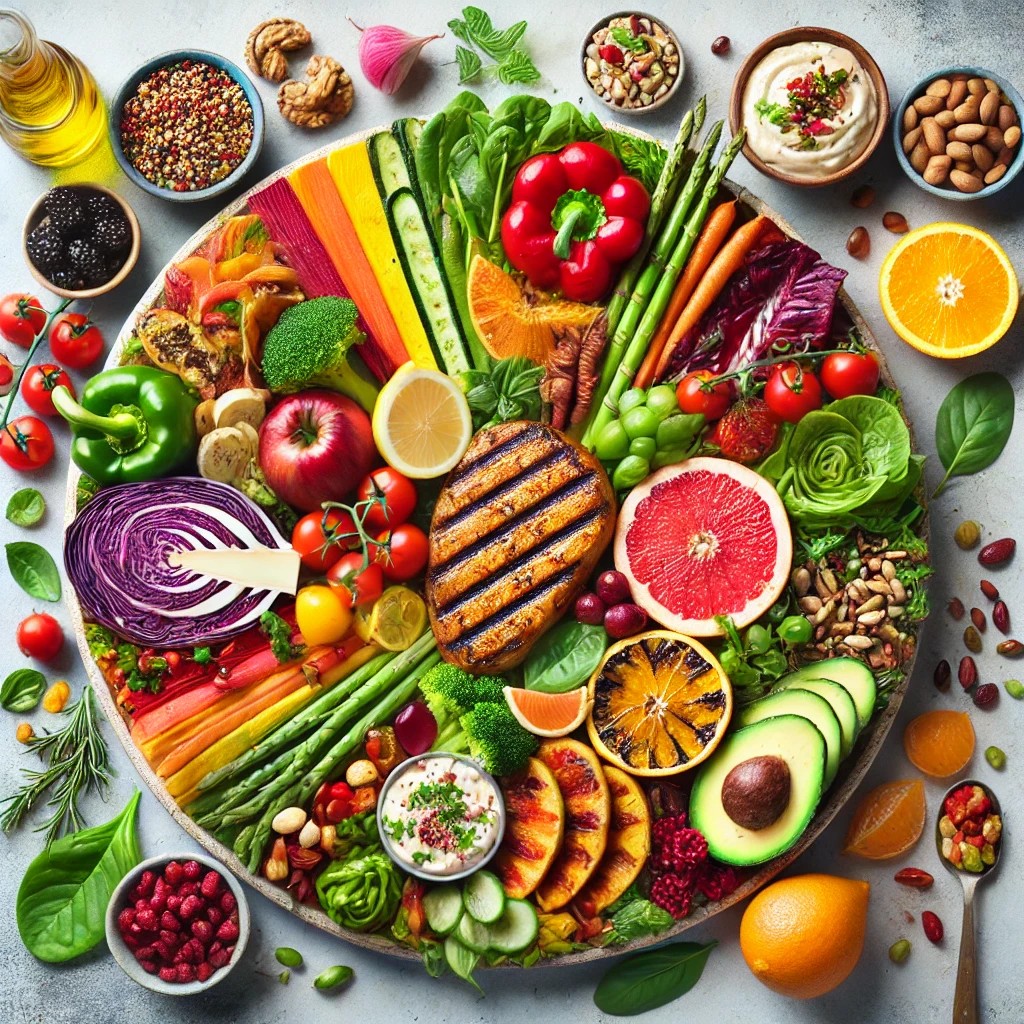
Fig. 2.7 above shows a vibrant plate of diverse foods showing several colors, textures, and flavors.
8. Planning for Dietary Restrictions and Preferences
Planning meals for dietary restrictions and preferences ensures that everyone can enjoy safe at the table, satisfying, and nutritious food. Start by identifying specific needs, such as allergies, intolerances, or lifestyle choices like vegetarianism or keto diets. Use substitutions to adapt recipes without compromising flavor, such as using almond milk instead of dairy or gluten-free flour for baking. Incorporate a variety of foods to meet nutritional requirements and avoid monotony. Planning allows you to create inclusive meals while reducing stress and making it easier to accommodate diverse dietary needs seamlessly. Customizing meal plans to suit dietary needs is essential for inclusivity and health:
Allergies: Create nut-free, dairy-free, or gluten-free meals.
Preferences: Accommodate vegan, vegetarian, or pescatarian diets.
Health Conditions: Plan for low-sodium, diabetic-friendly, or heart-healthy meals.
Tips:
- Use substitutes like almond milk for dairy or quinoa for gluten-based grains.
- Consult with a nutritionist for personalized plans.
Visual: A customizable meal planning chart with options for dietary restrictions.
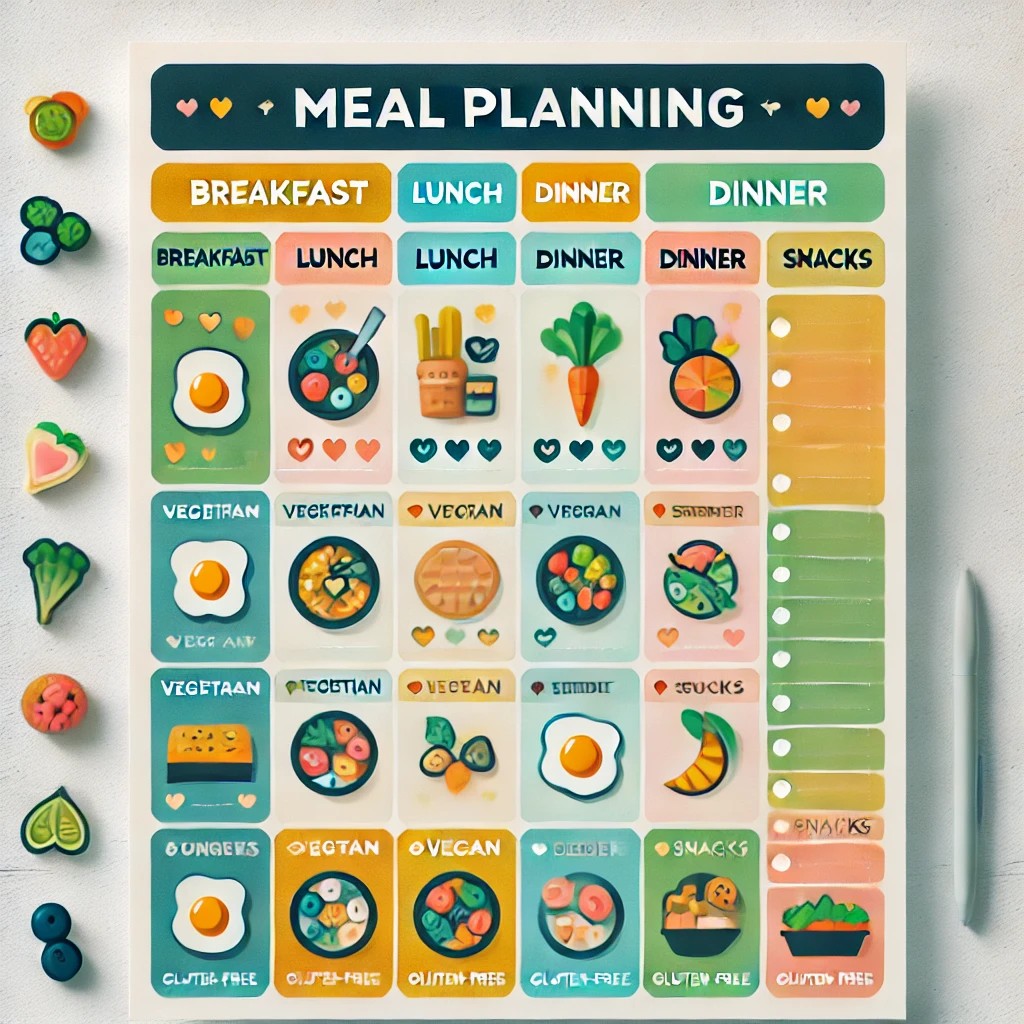
Fig. 2.8 above shows a customizable meal planning chart with options for dietary restrictions.
9. Healthy Snacks and Hydration
Proper hydration and healthy snacks are necessary to maintain energy levels, and overall well-being during the day. Opt for nutrient-dense snacks like fruits, nuts, yogurt, or whole-grain options to curb hunger and, provide sustained energy. Abstain processed snacks as they are high in sugar content and unhealthy fats. Staying hydrated is equally important; aim to drink plenty of water, and include options like herbal teas or infused water for variety. Proper hydration supports digestion, brain function, and physical performance, making it, a vital component of a balanced lifestyle. Together, healthy snacks and hydration contribute to feeling your best every day. Snacking and hydration are integral to maintaining energy levels throughout the day:
Healthy Snacks: Opt for nuts, yogurt, fresh fruits, or hummus with veggies.
Hydration: Drink at least 8 cups of water daily; include herbal teas or infused water.
Tips:
Prepare snack packs for portion control.
Avoid sugary beverages; replace them with natural options.
Visual: Snack board with portioned nuts, fruits, and a mason jar of infused water.

Fig. 2.9 above shows a snack board with portioned nuts, fruits, and a mason jar of infused water.
10. Tracking Progress and Adjusting Plans
Tracking your progress is pivotal to achieving your health and wellness goals. Regularly monitor your meals, portion sizes, and overall habits to identify what works and, what does not. Tools like meal logs, fitness apps, or progress journals can help you stay consistent. Based on your observations, adjust your meal plans to better align with your goals, whether it is improving nutrition, weight management, or accommodating lifestyle changes. This process ensures your approach remains flexible, effective, and sustainable, empowering you to stay on track and make informed decisions for lasting success. Monitoring your meal plan ensures it continues to meet your goals:
Monitoring your meal plan ensures it continues to meet your goals:
Evaluate: Track energy levels, weight changes, or health markers.
Adjust: Modify recipes and portion sizes based on feedback.
Involve Family: Incorporate input from household members.
Pro Tips:
- Use apps or journals to log meals and assess nutritional balance.
- Celebrate milestones to stay motivated.
Visual: A progress tracker template with sections for goals, meals logged, and results.

Fig. 2.10 above shows a progress tracker template with sections for goals, meals logged, and results.
Conclusion
Balanced meal planning is a powerful tool for achieving and maintaining optimal health. By following the strategies outlined in this guide, you can create meals that are nutritious, delicious, and suited to your unique lifestyle. Start your journey today toward better health and a more organized, stress-free approach to eating.

